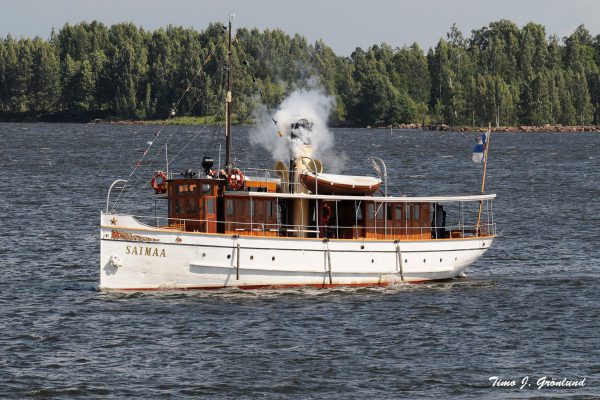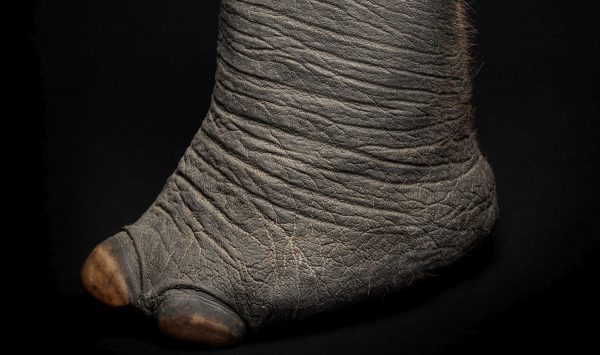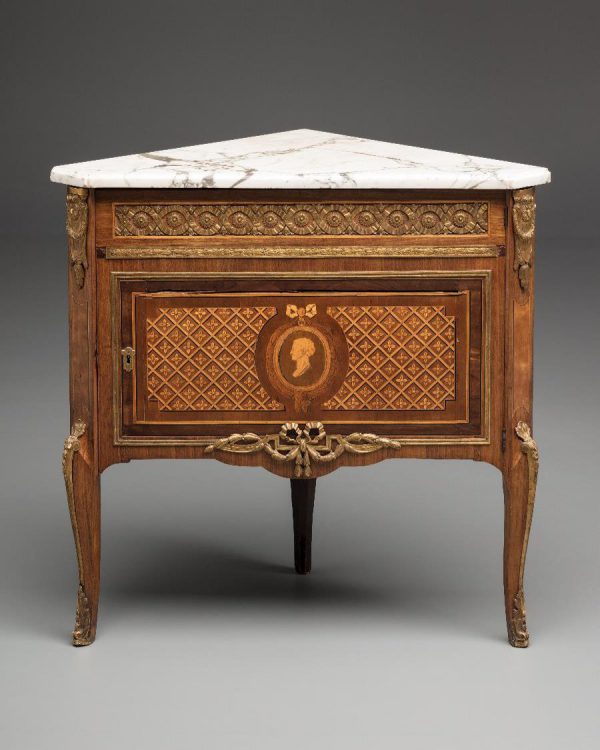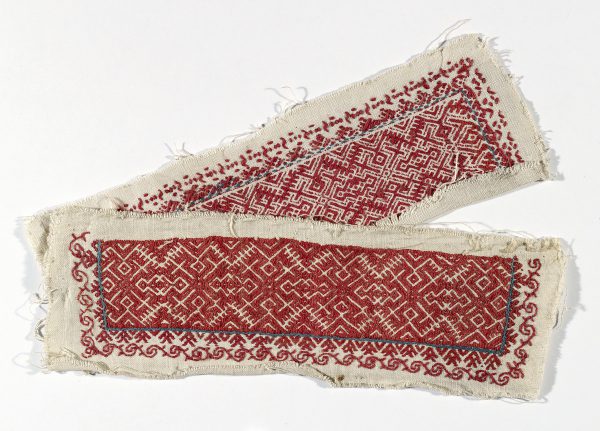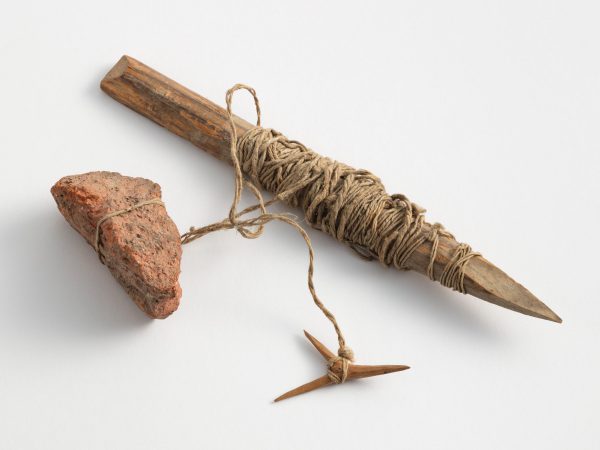Muiskas from White Karelia
Artefact of the month - February 2024
Journalist I. K. Inha (1865–1930) purchased these muiskas, or embroidered shoulder pieces for a women’s shirt, in Kokkosalmi, White Karelia. He went on a five-month trip there with the linguist K. F. Karjalainen (1871–1919) in 1894.
The funding application submitted by Inha to the Finnish Literature Society reveals that the primary purpose of the trip was to take photographs that could be used to illustrate the Kalevala and supplement Elias Lönnrot’s account of his travels. Inha had trained in photography in Grönenbach in Southern Bavaria and in Vienna in 1889.
The photographs that Inha took in White Karelia are well known, but in addition to them, he also collected approximately 100 artefacts that are stored in the Finno-Ugric collections of the National Museum of Finland (called the State Historical Museum at that time). In this part of the collection, the number of textile items is considerable. In addition to women’s shirts and shoulder decorations, it includes long towels called käspaikka, women’s headdresses called sorokka, embroidery patterns as well as embroidered mittens and socks. There are over 60 such textile items.
The pattern of the muiska selected as the artefact of the month is geometric in style and it was sewn using the traditional Karelian method virvittäin. It was originally listed in the inventory, apparently by Inha, under the name “Sunkun koava?”. The museum has later supplemented the information concerning the item with an entry explaining that this might be a reference to the Russian city of Shunga which is where the pattern for the embroidery originated. The city, which was located on the shore of Lake Onega, was where people from White Karelia went to in the late 1800s if they needed to buy anything, as trade with Finnish people had decreased. Inha writes that, in wintertime, people took game and furs to Shunga and took home with them fabrics as well as sewing and luxury items.
Documenting a White Karelian wedding
An important event on Inha and Karjalainen’s trip was the “play wedding” organised for them. It followed traditional wedding ceremonies. The play wedding was a performance depicting a traditional wedding, and Inha photographed the performance. Based on interviews and his own observations of the wedding, Inha’s travelling companion K. F. Karjalainen wrote a several dozen pages long wedding description which was published as part of Kalevalan laulumailta, Inha’s account of their travels. For the two travellers, the wedding represented old and original Karelian culture with its multi-step preparations and magical rites.
Textiles were an important part of traditional wedding celebrations, and they also interested Inha from the perspective of artefact collection. The bride prepared herself a dowry which she took with her when she moved out of her childhood home. In addition, she also gave textiles as gifts to her wedding guests, future family members and wedding officials. Families prepared for their daughters’ marriages by collecting embroidered textiles, such as muiskas, for their dowries. In cases of old and worn shirts, the muiskas could be cut off and used again.
Inha writes how he managed to purchase “from Ukhta a whole bunch of embroidery, some of them made with silk, showcasing quite original designs. Nowadays, this sewing skill has been completely forgotten, but here and there muiskas can still be found at the bottom of chests and people are willing to part with them without missing them later.”
Wiping away modernity
Inha and Karjalainen’s trip took place at a time when industrially produced fabrics were starting to become widely available. Inha realised that traditional craftsmanship and embroidery skill were disappearing. Young women were already using Russian-style sarafans made from purchased fabrics instead of the original kostos. Men’s suits, on the other hand, were consistent with the Finnish and Russian suits and did not have any distinctively Karelian features.
The “Kalevala” (1835 and 1849) influenced the way Finnish Karelianists, who travelled around White Karelia in the 1890s and of whom Inha was one of them, observed and interpreted Karelian culture. Inha writes how the inspiration for his trip stemmed from “the homeland of the ‘Kalevala’ and the ancient poems that Lönnrot has compiled” which he regarded as forgotten at the time. The past became an object of interest. “I spent my days walking around the village, looking for all kinds of old things: buildings, woodcuts, pieces of embroidery, upright men and mourner women...”
Inha used his skills as a journalist to make observations of what he saw. He noticed a change in culture and society, although this is not apparent in his collection of artefacts. He noted that the everyday items used in houses in White Karelia were newer than those used in the Finnish South Karelia and that the houses were more modern than in Savonia. The samovar and tea drinking were a novelty in northern Russia and Karelia in the second half of the 1800s, and Inha documented this, but not through artefacts. He must also have been disappointed to some degree by how he did not manage to see a single kantele on his trip and by how unknown the instrument was.
Inha collected artefacts through which it was possible to go back in time to something that could be defined as “part of the world of the ‘Kalevala’”. The embroidered textiles that were no longer used and which had survived through generations were a gateway to the time of “moamon moamo”, mother’s mother, or a point even further back in time. These items include pieces of fabric such as muiskas, otsamuses for sorokkas and embroidery patterns.
In addition to Inha, many other collectors and travellers from artists to architects documented decorative expression and ornamentation in the Republic of Karelia in the late 1800s, especially in the 1890s. Material was collected to support the cultivation of the Finnish style. At the same time, many of the phenomena of Karelian culture were ignored and left unrecorded. Kalevala Day, simultaneously the Day of Finnish Culture, is celebrated on 28 February. It is a reminder that the Finnish identity and Finnish culture were built using elements from Karelian culture that were moulded to meet Finnish people’s national goals.
Anna-Mari Immonen
Literature
Inha, I. K. 1999 (1911): Kalevalan laulumailla. Elias Lönnrotin poluilla Vienan Karjalassa. Kuvaus Vienan Karjalan maasta, kansasta, siellä tapahtuneesta runonkeruusta ja runoista itsestään. Pekka Laaksonen (toim.). Suomalaisen Kirjallisuuden Seura: Helsinki.
Sihvo, Hannes 1973: Karjalan kuva. Karelianismin taustaa ja vaiheita autonomian aikana. Suomalaisen Kirjallisuuden Seuran Toimituksia 314. Suomalaisen Kirjallisuuden Seura: Helsinki.


